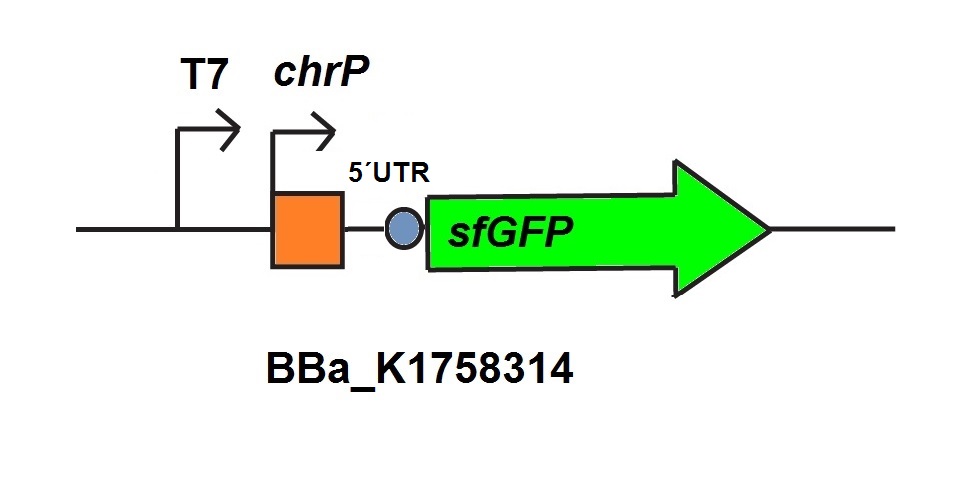Difference between revisions of "Part:BBa K1758310"
| Line 19: | Line 19: | ||
<!-- --> | <!-- --> | ||
| − | + | <html> | |
<h2><i>in vitro</i></h2> | <h2><i>in vitro</i></h2> | ||
| Line 27: | Line 27: | ||
<div class="row"> | <div class="row"> | ||
| − | <div class="col-md-6 text-center" style="margin-bottom: 50px"> <figure style="width: | + | <div class="col-md-6 text-center" style="margin-bottom: 50px"> <figure style="width: 300px"> |
<a href="https://static.igem.org/mediawiki/2015/e/e4/Bielefeld-CeBiTec_in_vitro_ChrB-part.jpeg" data-lightbox="heavymetals" data-title="Figure 5: To produce the cell extract for <i>in vitro</i> characterization a construct (BBa_K1758310 ) with chromium repressor under the control of a constitutive promoter and strong RBS (BBa_K608002) is needed. " https://static.igem.org/mediawiki/2015/e/e4/Bielefeld-CeBiTec_in_vitro_ChrB-part.jpeg" alt="repressor construct used for in vivo characterization."><img src=" https://static.igem.org/mediawiki/2015/e/e4/Bielefeld-CeBiTec_in_vitro_ChrB-part.jpeg" alt="repressor construct used for in vivo characterisation"></a> <figcaption> Figure 5: To produce the cell extract for <i>in vitro</i> characterization a construct (<a href="https://parts.igem.org/Part:BBa_K1758310" target="_blank">BBa_K1758310</a> ) with chromium repressor under the control of a constitutive promoter and strong RBS (BBa_K608002) is needed.</figcaption> | <a href="https://static.igem.org/mediawiki/2015/e/e4/Bielefeld-CeBiTec_in_vitro_ChrB-part.jpeg" data-lightbox="heavymetals" data-title="Figure 5: To produce the cell extract for <i>in vitro</i> characterization a construct (BBa_K1758310 ) with chromium repressor under the control of a constitutive promoter and strong RBS (BBa_K608002) is needed. " https://static.igem.org/mediawiki/2015/e/e4/Bielefeld-CeBiTec_in_vitro_ChrB-part.jpeg" alt="repressor construct used for in vivo characterization."><img src=" https://static.igem.org/mediawiki/2015/e/e4/Bielefeld-CeBiTec_in_vitro_ChrB-part.jpeg" alt="repressor construct used for in vivo characterisation"></a> <figcaption> Figure 5: To produce the cell extract for <i>in vitro</i> characterization a construct (<a href="https://parts.igem.org/Part:BBa_K1758310" target="_blank">BBa_K1758310</a> ) with chromium repressor under the control of a constitutive promoter and strong RBS (BBa_K608002) is needed.</figcaption> | ||
</figure> | </figure> | ||
</div> | </div> | ||
| − | <div class="col-md-6 text-center" style="margin-bottom: 50px"> <figure style="width: | + | <div class="col-md-6 text-center" style="margin-bottom: 50px"> <figure style="width: 300px"> |
<a href="https://static.igem.org/mediawiki/2015/1/1f/Bielefeld-CebiTec_in_vitro_T7-chrP-UTR-sfGFP.jpeg" data-lightbox="heavymetals" data-title="T7-chrP-UTR-sfGFP construct used for<i>in vitro</i> characterization." https://static.igem.org/mediawiki/2015/1/1f/Bielefeld-CebiTec_in_vitro_T7-chrP-UTR-sfGFP.jpeg" alt="promoter construct used for in vivo characterization."><img src=" https://static.igem.org/mediawiki/2015/1/1f/Bielefeld-CebiTec_in_vitro_T7-chrP-UTR-sfGFP.jpeg" alt="promoter construct used for in vivo characterisation "></a> <figcaption> T7-chrP-UTR-sfGFP <a href="https://parts.igem.org/Part:BBa_K1758314" target="_blank">BBa_K1758314</a> used for<i>in vitro</i> characterization.</figcaption> | <a href="https://static.igem.org/mediawiki/2015/1/1f/Bielefeld-CebiTec_in_vitro_T7-chrP-UTR-sfGFP.jpeg" data-lightbox="heavymetals" data-title="T7-chrP-UTR-sfGFP construct used for<i>in vitro</i> characterization." https://static.igem.org/mediawiki/2015/1/1f/Bielefeld-CebiTec_in_vitro_T7-chrP-UTR-sfGFP.jpeg" alt="promoter construct used for in vivo characterization."><img src=" https://static.igem.org/mediawiki/2015/1/1f/Bielefeld-CebiTec_in_vitro_T7-chrP-UTR-sfGFP.jpeg" alt="promoter construct used for in vivo characterisation "></a> <figcaption> T7-chrP-UTR-sfGFP <a href="https://parts.igem.org/Part:BBa_K1758314" target="_blank">BBa_K1758314</a> used for<i>in vitro</i> characterization.</figcaption> | ||
</figure> | </figure> | ||
| Line 98: | Line 98: | ||
</p> | </p> | ||
</div> | </div> | ||
| + | |||
| + | </html> | ||
Revision as of 04:21, 19 September 2015
Chromium repressor under control of constitutive promoter and strong RBS
Repressor for chromium responsive promoter ChrP under the control of the konstitutive promoter (K608002)
Usage and Biology
We used this repressor for our chromium sensor. Originaly its from Ochrobactrum triti ci5bvl1. We codon optimized it for use in E.coli. It is essential for our chromium sensor device BBa_K1758313
Sequence and Features
- 10COMPATIBLE WITH RFC[10]
- 12INCOMPATIBLE WITH RFC[12]Illegal NheI site found at 55
Illegal NheI site found at 966
Illegal NheI site found at 989 - 21COMPATIBLE WITH RFC[21]
- 23COMPATIBLE WITH RFC[23]
- 25INCOMPATIBLE WITH RFC[25]Illegal AgeI site found at 124
- 1000COMPATIBLE WITH RFC[1000]
in vitro
For the characterization of the chromium sensor with CFPS we used parts differing from that we used in vivo characterization. For the in vitro characterization we used a cell extract produced from cells which contain the plasmid (BBa_K1758310). The plasmid contains the gene chrB under the control of a constitutive promoter, so that the cell extract is enriched with repressor molecules. In addition to that we added plasmid-DNA of the chromium specific promoter chrP with 5’UTR-sfGFP under the control of T7-promoter (BBa_K1758314 (figure 6))to the cell extract. The T7-promoter is needed to get a better fluorescence expression.



Chromium’s influence on the cell extract as shown in figure 7 is minimal for low concentrations. Higher chromium concentrations have a measurable impact on the viability of the cell extract, which is visible at concentrations of 120 µg/L and obvious at concentrations of 240 µg/L chromium.

The decrease of fluorescence for higher chromium concentrations in chromium specific cell extract is shown in figure 8. An increase of fluorescence at higher chromium concentrations would have been expected resulting out of the induction of the chromium sensor. A factor which should be considered is the influence of high chromium concentrations to the cell extract. The test for influence of chromium on the specific cell extract, illustrated in figure 7 showed that the influence of chromium at low concentrations is not significant. But the graphic shows that high concentrations of chromium induce fatal damages to the cell extract.

Taking the influence of different chromium concentrations under consideration measured fluorescence can be normalized on chromium’s influence on the cell extract (figure 9). Normalized data suggest, that higher concentrations of chromium induce fluorescence in relevance to chromium’s influence on the cell extract.


In addition to the measurements of our chromium sensor in CFPS we measured our chromium inducible promoter with the repressor of team Dundee (figure 10, 11), which works similar to ours. In contrast to our repressor only first 15 codons of their repressor are codon-optimized. Measurements with their repressor showed tendencies similar to our measured repressor. After normalization induction with higher chromium concentrations showed a detectable fluorescence response for both measured datasets.
References
Guidelines for drinking-water quality (2011). 4th ed. Geneva: World Health Organization, zuletzt geprüft am 20.08.2015.
Mitchell D. Cohen; Biserka Kargacin; Catherine B. Klein; and Max Costa: Mechanisms of Chromium Carcinogenicity and Toxicity, zuletzt geprüft am 19.08.2015.
Paustenbach, Dennis J.; Finley, Brent L.; Mowat, Fionna S.; Kerger, Brent D. (2003): Human health risk and exposure assessment of chromium (VI) in tap water. In: Journal of toxicology and environmental health. Part A 66 (14), S. 1295–1339. DOI: 10.1080/15287390306388.
WHO (2003): Mercury in Drinking-water Background document for development of WHO Guidelines for Drinking-water Quality, checked 15.08.15
